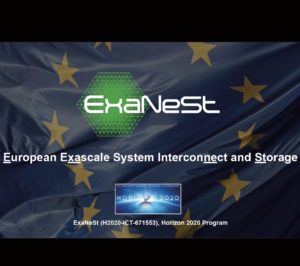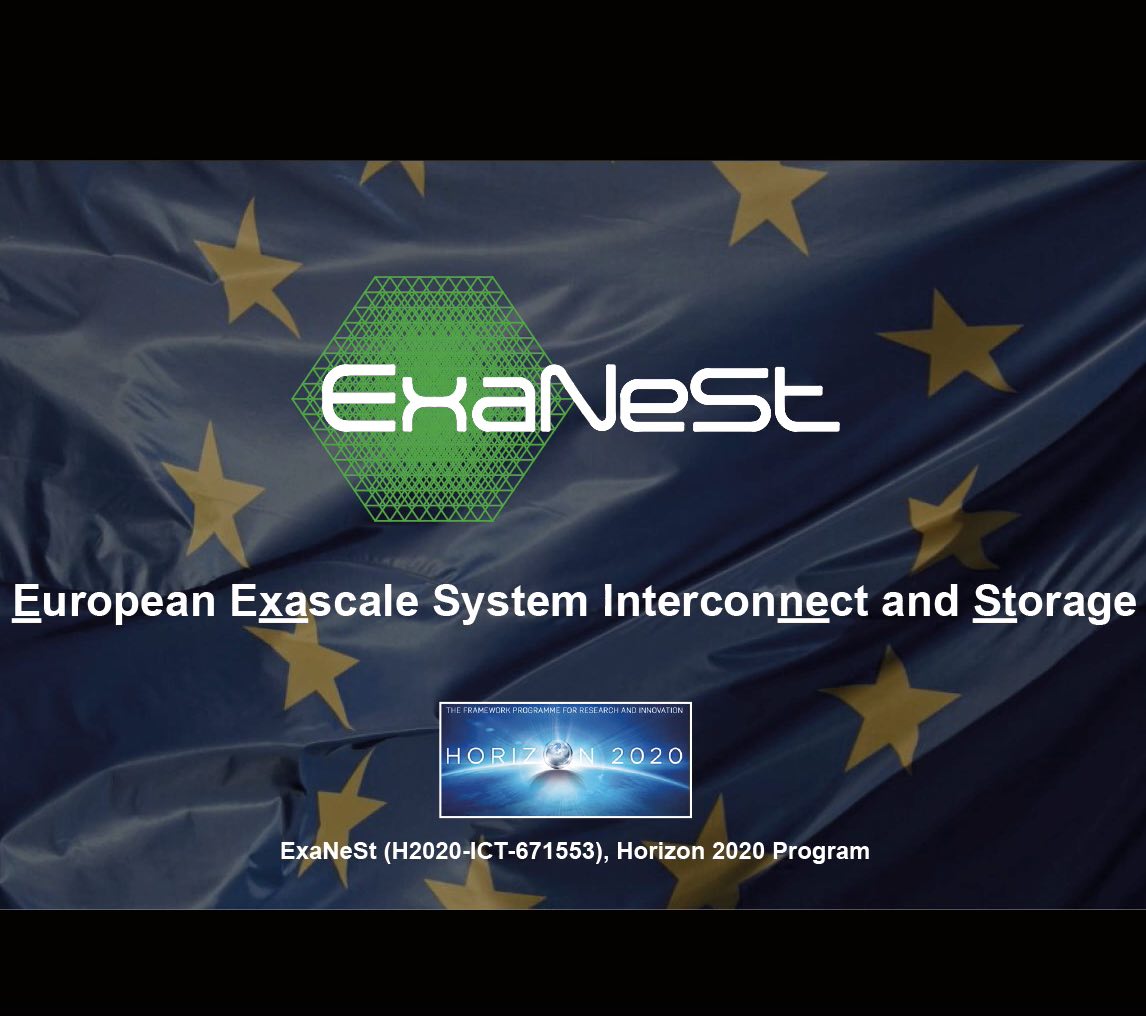 In this video, researchers describe the results from the ExaNeSt project.
In this video, researchers describe the results from the ExaNeSt project.
Today the whole world is trying to push supercomputer technology to the exascale level, i.e. a billion billion calculations per second. In Europe, this exascale vision will be made possible with contributions by Consortia funded by the Horizon 2020 Programme of the EU in projects such as ExaNeSt, which built a first ‘straw man’ prototype, having worked on this since 2016.
The ExaNeSt Consortium consists of twelve partners across seven EU countries, each of them with expertise in a core technology needed for innovation to reach exascale. ExaNeSt has taken a sensible integrated approach to co-design the hardware and software that is needed to enable the prototype to run in real-life evaluations.
The prototype is now successfully built, demonstrating energy efficiency in a High-Performance Computing (HPC) testbed: the energy consumed for solving a given problem on this new platform is 3 to 10 times lower than what traditional HPC processors of the same time generation consume for solving the same problem. The substantial prototype has been validated through the execution of full HPC applications from materials science, climate forecasting, computational fluid dynamics, astrophysics, neuroscience, and a database.

Manolis Katevinis (right) from FORTH discusses ExaNest project challenges with Rich Brueckner from insideHPC.
ExaNeSt addressed key issues such as energy efficiency by using ARM cores, moving data across shorter distances, and avoiding unneeded copyings of data; it uses power-efficient and silent liquid cooling; the prototype has non-volatile memories integrated into the processor fabric and innovative fast interconnects, while we worked to avoid congestion.
ExaNeSt has contributed to a new generation of European Supercomputers, thus creating new business opportunities. The project’s advances in performance and efficiency will enable SME’s in several sectors of the economy to utilize HPC and data analytics, with an attractive trade-off between usability and affordability. ExaNeSt has also educated numerous young engineers, contributing to close the large skills gap in academia and industry.
The energy-efficient solutions are expected to spread to standard off the shelf computing systems, assisting the efforts of the EU to reduce carbon dioxide emissions and reach environmental targets.
ExaNeSt collaborates with other European R&D projects and partners, including:
- EuroServer, which developed the underlying efficient communication between ARM processors
- ExaNoDe, which focused on novel three-dimensional integration technologies and on systems software
- ECOSCALE, which develops programmable-hardware accelerators for specialized computations
- EuroEXA, which is the follow-on project of the above
- Kaleao Ltd., which enables and produces new generation computing platforms by converging compute, storage, and networking into efficient, extremely compact, and transparent server solutions.
- Xilinx Inc., providing FPGA technology and flexible high speed communication.
- Micron Inc., for advanced low power memory and storage technology.
Key contributors include:
- FORTH is a world renowned research centre in Greece; it provides, through its Institute of Computer Science, expertise in interconnection networks, storage systems software, and prototyping.
Visit - Iceotope provides reliable, energy efficient liquid cooling solutions for electronics to deliver a sustainable environment.
Visit - Ex-“Allinea”, now part of Arm is the leading developer of scalable development and performance analysis tools for high performance computing. Its tools are used on 80% of the world’s largest supercomputers and enable scientists, researchers and engineers in research and industry to achieve better results from HPC clusters quickly and efficiently.
Visit - EnginSoft is an Italy-based multinational consulting company, which is active in the field of Simulation-Based Engineering and Sciences (SBES).
Visit - ExactLabs is an innovative start-up in the area of HPC, providing advanced services for scientific computation and data management.
Visit - MonetDB Solutions is the technical consulting company for the open-source column-based database system MonetDB, specialised in database technologies for Business Intelligence and Big Data Analytics. In MonetDB Solutions, world-leading database researchers and engineers support software companies in developing leading edge applications addressing vertical markets, e.g., telecom, health care and education.
Visit - Fraunhofer Institute for Industrial Mathematics (ITWM) in Kaiserslautern, Germany, focuses on mathematical approaches to practical challenges like optimisation and visualisation.
Visit - Virtual Open Systems is a France-based high-tech company active in virtualization and embedded software development. The areas of expertise through open source software development include networking and accelerators virtualization, automotive virtualized systems, security, and QoS for embedded systems.
Visit: - INAF is the leading Italian research institute in astronomy and Astrophysics. INAF contributed to network and storage design thanks to its HPC applications. INAF coordinated application related activities.
Visit: - INFN is one of the most influential and prestigious scientific institutions in the world, dedicated to research on nuclear and subnuclear fundamental Physics through home-developed cutting-edge instruments and technologies. INFN contribution in ExaNeSt focused on network development and system benchmarking using its proprietary, large scale, neuroscience application code.
Visit: - The University of Manchester is one of the UK’s top research-led universities; the APT group is well known for its million-core SpiNNaker system. The group is also working across a range of Exascale challenges and provided this consortium with wide expertise across interconnects, large-scale systems, HPC and data analytic applications and system manufacturing.
Visit: - UPV (GAP) provided strong expertise in interconnection networks and delivered photonic solutions for post-ExaNeSt systems.





